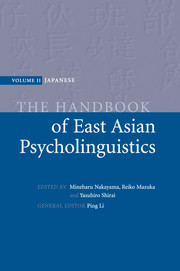Book contents
- Frontmatter
- Contents
- List of figures
- List of contributors
- In memory of Miwa Nishimura
- Preface
- Introduction
- Language acquisition
- Part II Language processing
- 26 The phonetic and phonological organization of speech in Japanese
- 27 Speech segmentation by Japanese listeners: its language-specificity and language-universality
- 28 Prosody in sentence processing
- 29 Speech errors
- 30 Effects of word properties on Japanese sentence processing
- 31 Orthographic processing
- 32 Lexical access
- 33 Incrementality in Japanese sentence processing
- 34 Processing alternative word orders in Japanese
- 35 Processing relative clauses in Japanese: coping with multiple ambiguities
- 36 Processing empty categories in Japanese
- 37 The difficulty of certain sentence constructions in comprehension
- 38 Reading and working memory
- 39 Sentence production in Japanese
- 40 The neural basis of syntactic processing in Japanese
- 41 The competition model
- 42 Connectionist models
- 43 Computational linguistics
- 44 Language and gesture as a single communicative system
- References
- Name index
- Subject index
40 - The neural basis of syntactic processing in Japanese
from Part II - Language processing
Published online by Cambridge University Press: 05 June 2012
- Frontmatter
- Contents
- List of figures
- List of contributors
- In memory of Miwa Nishimura
- Preface
- Introduction
- Language acquisition
- Part II Language processing
- 26 The phonetic and phonological organization of speech in Japanese
- 27 Speech segmentation by Japanese listeners: its language-specificity and language-universality
- 28 Prosody in sentence processing
- 29 Speech errors
- 30 Effects of word properties on Japanese sentence processing
- 31 Orthographic processing
- 32 Lexical access
- 33 Incrementality in Japanese sentence processing
- 34 Processing alternative word orders in Japanese
- 35 Processing relative clauses in Japanese: coping with multiple ambiguities
- 36 Processing empty categories in Japanese
- 37 The difficulty of certain sentence constructions in comprehension
- 38 Reading and working memory
- 39 Sentence production in Japanese
- 40 The neural basis of syntactic processing in Japanese
- 41 The competition model
- 42 Connectionist models
- 43 Computational linguistics
- 44 Language and gesture as a single communicative system
- References
- Name index
- Subject index
Summary
Introduction
Linguistics, as one of general cognitive theories, has been clarifying the unconscious knowledge of how the syntactic structure of sentences is represented. Psycholinguistics has been concerned with the algorithms that implement this knowledge when we speak and understand. Neurolinguistics, or the study of the brain–language relations, has been seeking to find the neural mechanisms that instantiate these algorithms and their cerebral localization in the human brain. It is by now a commonly shared view that the brain is a computational device that combines and transforms information. Among various research domains that investigate the brain, one approach that linguistics can take at the moment is to hypothesize that each mental operation posited by linguistic theory corresponds to a computation carried out by the brain. By corroborating the neural reality of abstract mental representation and operations, we hope eventually to construct a biologically feasible brain theory of human language processing.
Minimalist model of the language faculty
Much of the current model of linguistic knowledge, known as the “Minimalist Program” of generative grammar (Chomsky, l995), consists of a computational system, called “Syntax,” as its core, and a lexicon, as shown in figure 40.1.
The Syntax first selects elements from the lexicon and then uses them to create hierarchical syntactic structures by means of the combinatorial operation, called “Merge.” This operation takes place recursively until all the lexical items, each of which consists of bundles of abstract features and is selected from the lexicon, are used up.
- Type
- Chapter
- Information
- The Handbook of East Asian Psycholinguistics , pp. 298 - 306Publisher: Cambridge University PressPrint publication year: 2006



